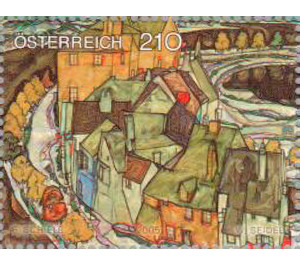painting - Austria / II. Republic of Austria 2005 - 210 Euro Cent
Theme: Art & Culture
| Country | Austria / II. Republic of Austria |
| Issue Date | 2005 |
| Face Value | 210.00 |
| Edition Issued | 500,000 |
| Printing Type | combination printing |
| Stamp Type | Commemorative |
| Item Type | Stamp |
| Chronological Issue Number | 1889 |
| Chronological Chapter | OOS-OE2 |
| SID | 851900 |
| In 24 Wishlists | |
Egon Schiele was born on 12 June 1890 in Tulln / Lower Austria, the son of a railway official. His teachers at the Realgymnasium Klosterneuburg noticed at an early stage his exceptional talent and promoted the way to the Academy of Fine Arts. The rigidity of the academic enterprise led the young artist to quit after only two years and to form the "Neukunstgruppe" with some friends. In 1909 Schiele celebrated his first successes and learned about the art critic Arthur Roessler patrons such as Reininghaus and Dr. med. Reichel, who secured his financial survival. In 1910 Schiele left Vienna and stayed in Krumau (South Bohemia) and Neulengbach, where he was convicted of alleged abuse of minors and was put in jail. Whether he was really guilty or had only used the children as models remained unclear, but he managed to regain his footing in Vienna in 1912. After his military convocation, he married, in 1917 he was assigned to the service in Vienna and was therefore able to devote himself to his art despite the turmoil of the First World War. A few months after the death of his friend Gustav Klimt in 1918, the worldwide devastating "Spanish flu" was also raging in Vienna. Egon Schiele succumbed to this disease only 3 days after his wife's death on October 31, 1918. His expressionist portraits and nudes, which are world-famous today, speak of suffering, loneliness, youth, age, eroticism and dying. The landscapes and cityscapes of Schiele with their expressive surface divisions have never achieved the same level of popularity, although they represent about half of his artistic output. The painting is owned by the Leopold Museum in Vienna, which owns the largest collection of Schiele's works. The autumn exhibition of 2004 in the Leopold Museum was dedicated to the landscapes of Egon Schiele. Prof. Rudolf Leopold, born on March 1, 1925 in Vienna, began his collection during his studies. He concentrated on Schiele, who was still little respected, and thus laid the foundation for the important collection. In 1994 he founded the Leopold Museum Private Foundation together with the Republic of Austria, and in 2001 the collection found its new home in the Leopold Museum. It is located in the Museumsquartier Wien, which opened on 22 September 2001, the former imperial court stables, one of the ten largest cultural areas in the world.


